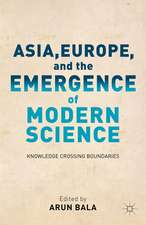The Wheel–Turner and His House – Kingship in a Buddhist Ecumene
Autor Geok Gohen Limba Engleză Paperback – 29 noi 2014
The recorded history of precolonial Burmese empire and the modern state of Myanmar starts with the kingdom of Bagan in the 11th century. The oldest surviving written records and structures are from the reign of King Anawrahta (1044–1077). Anawrahta converted to Theravada Buddhism and created a vibrant Buddhist state in the Irrawaddy River basin. Anawrahta is a folk hero to this day in Myanmar and is widely credited as a charismatic and pious leader who consolidated various ethnic groups throughout the region into a single nation.
The Wheel-Turner and His House traces the archaeological and historical record of Anawrahta and his seminal position in forming modern Myanmar, based on the few sources that have been recovered. The Great Chronicle, an important history of the country written by the 18th-century Burmese nobleman U Kala, forms the basis for much of the knowledge we have about Anawrahta today. Geok Yian Goh examines U Kala’s work in light of the context of U Kala’s own time and points out the bias of his royal court, as well as the scribe’s personal views from the elaborate narratives he produced. She looks at other sources as well, including unpublished palm-leaf manuscripts, to disentangle earlier knowledge about Anawrahta and 11th-century Bagan. Placing the overall study of Burmese historical tradition within the larger manuscript culture of Asia, Goh presents a critique of theoretical issues in history, especially the relationship between the past and memory.
In order to analyze the expansion of Anawrahta’s historical image that formed the development of a Buddhist ecumene in the 11th and 12th centuries, Goh utilizes published and unpublished texts in Burmese and classical Chinese, along with northern Thai and Sri Lankan texts, many of which Goh makes available for the first time in English.
The Wheel-Turner and His House traces the archaeological and historical record of Anawrahta and his seminal position in forming modern Myanmar, based on the few sources that have been recovered. The Great Chronicle, an important history of the country written by the 18th-century Burmese nobleman U Kala, forms the basis for much of the knowledge we have about Anawrahta today. Geok Yian Goh examines U Kala’s work in light of the context of U Kala’s own time and points out the bias of his royal court, as well as the scribe’s personal views from the elaborate narratives he produced. She looks at other sources as well, including unpublished palm-leaf manuscripts, to disentangle earlier knowledge about Anawrahta and 11th-century Bagan. Placing the overall study of Burmese historical tradition within the larger manuscript culture of Asia, Goh presents a critique of theoretical issues in history, especially the relationship between the past and memory.
In order to analyze the expansion of Anawrahta’s historical image that formed the development of a Buddhist ecumene in the 11th and 12th centuries, Goh utilizes published and unpublished texts in Burmese and classical Chinese, along with northern Thai and Sri Lankan texts, many of which Goh makes available for the first time in English.
Preț: 324.32 lei
Nou
Puncte Express: 486
Preț estimativ în valută:
62.06€ • 65.29$ • 51.52£
62.06€ • 65.29$ • 51.52£
Carte tipărită la comandă
Livrare economică 16-30 ianuarie 25
Preluare comenzi: 021 569.72.76
Specificații
ISBN-13: 9780875807164
ISBN-10: 087580716X
Pagini: 250
Ilustrații: 4 illustrations, 6 maps
Dimensiuni: 153 x 229 x 21 mm
Greutate: 0.38 kg
Ediția:1
Editura: MB – Cornell University Press
ISBN-10: 087580716X
Pagini: 250
Ilustrații: 4 illustrations, 6 maps
Dimensiuni: 153 x 229 x 21 mm
Greutate: 0.38 kg
Ediția:1
Editura: MB – Cornell University Press
Recenzii
“A must-read for those interested not only in pre-modern Southeast Asia, but also in understanding how the past is reinvented in our time.”
—Journal of the Siam Society
“Drawing upon a close critical analysis of extant Burmese sources as well as Chinese-language sources, this work is a significant accomplishment that will be of interest not only to Southeast Asia specialists, but also to historians of any field who are interested in the complex connections between history and memory.”
—American Historical Review
“Goh has made contributions to the study of Burmese history and, by extension, Burma Studies more widely.”
—New Mandala
“This book is one of a kind. There are only a very few historians both inside and outside the country of Geok’s generation who can do what she has done.”
—Michael Aung-Thwin, author of The Mists of Ramanna: The Legend that Was Lower Burma
“In exploring how Anawrahta’s reign has been presented or understood over the past several centuries, the author shows the range of historical sources that are available in this kind of endeavor and how they may be read and used in different ways . . . Recommended.”
—CHOICE
—Journal of the Siam Society
“Drawing upon a close critical analysis of extant Burmese sources as well as Chinese-language sources, this work is a significant accomplishment that will be of interest not only to Southeast Asia specialists, but also to historians of any field who are interested in the complex connections between history and memory.”
—American Historical Review
“Goh has made contributions to the study of Burmese history and, by extension, Burma Studies more widely.”
—New Mandala
“This book is one of a kind. There are only a very few historians both inside and outside the country of Geok’s generation who can do what she has done.”
—Michael Aung-Thwin, author of The Mists of Ramanna: The Legend that Was Lower Burma
“In exploring how Anawrahta’s reign has been presented or understood over the past several centuries, the author shows the range of historical sources that are available in this kind of endeavor and how they may be read and used in different ways . . . Recommended.”
—CHOICE
Notă biografică
Geok Yian Goh is assistant professor of history at Nanyang Technological University in Singapore.












